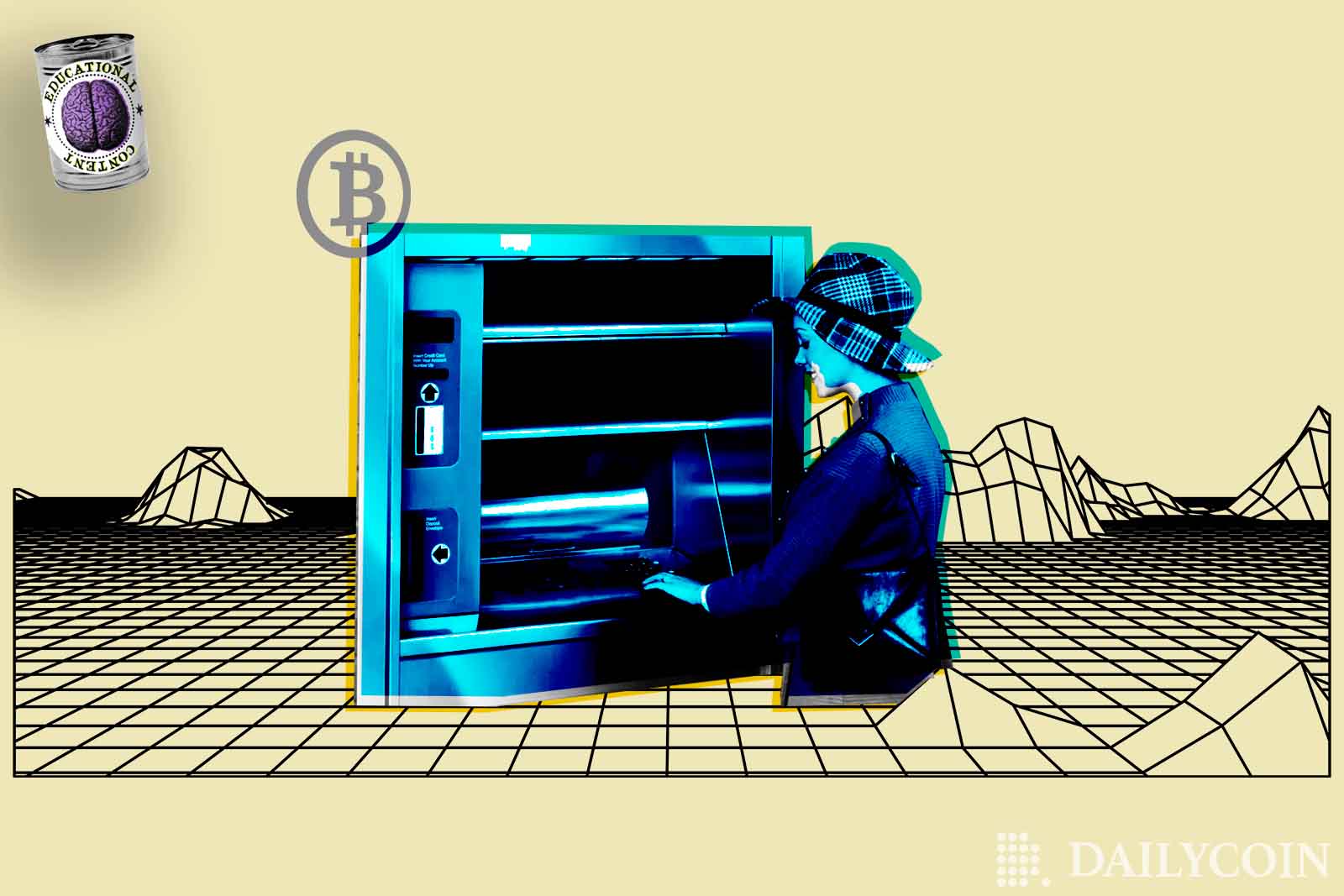
Every innovation exists on a fundamental infrastructure, however, this may not guarantee mainstream adoption. To progress beyond the experimental stage, the majority of innovative ideas or projects out there rely heavily on secondary infrastructure.
For cryptocurrency, secondary infrastructures such as smartphones, exchange marketplaces, and crypto ATMs play instrumental roles in driving mainstream adoption. Notably, crypto ATMs, unlike other secondary infrastructures, have more potential to drive adoption across emerging and developed markets, as well as different market segmentation.
Sponsored
If this is your first time hearing about crypto ATMs, do not feel bad as it is a relatively new technology; we mean it hasn’t been around for a decade. Thus, this article is meant to be a guide to explain everything you need to know about crypto ATMs.
Before we dig into details, you can picture a crypto ATM like a traditional fiat ATM. The major difference, however, is that instead of transacting with strictly fiat currency as with fiat ATMs, crypto ATMs are designed to be hybrid in nature. That said, let’s begin by introducing you to the history of crypto ATMs.
History of Crypto ATMs
When it comes to proprietary initiatives like crypto ATMs, many people try to make claim to being the frontrunner. However, the earliest crypto ATM goes back to sometime in October 2013.
At the time, a Robocoin machine reportedly opened in the Waves coffee shop in downtown Vancouver, Canada. This was believed by many sources including Wikipedia, to be the first-ever experimental crypto ATM to debut publicly.
Sponsored
Basically, being the world’s first, the crypto ATM introduced what can be described as a hybrid automated teller machine, as it essentially allows users to exchange their digital currency for cash and vice versa.
While Robocoin marked the first of its kind in Canada, another Bitcoin ATM sprang up barely two months after in Bratislava, Slovakia, marking the first of its kind in the European region.
Likewise in the United States, the first crypto ATM machine went live in May 2014, becoming the first of its kind to be licensed by a regulatory body. Notably, the machine was developed by Coinme and was installed at the Spitfire Grill in Seattle, Washington.
Almost a decade after the launch of the first ATM in Vancouver, over 36K Bitcoin ATMs have reportedly been installed all over the world. However, there are other sources that claim that the total number of installed crypto ATMs in the U.S. alone has surpassed 50K.
Either way, there has been an obvious increase in the installation of crypto ATMs around the world, further fostering mainstream adoption of cryptocurrency.
Understanding Crypto ATMs and How They Work
To understand how crypto ATMs work, it is important to understand what ATM really means. Well, the word ATM is not new, and probably most people have come across it and even use it for day-to-day transactions. So what does ATM mean?
An automated Teller Machine, or ATM as it is popularly known, is an electronic banking outlet that allows customers to execute simple transactions without the assistance of a bank representative.
Essentially, an ATM allows you to perform nearly everything you could do in a physical bank. So, with the exception of taking out a loan, investing, or paying certain invoices, you can use an ATM to conduct most of your financial transactions, including withdrawals and deposits.
A crypto ATM operates exactly the same way, with the exception that it processes both fiat and digital currencies, which ultimately makes it a hybrid machine.
That said, there are generally two main types of crypto ATMs; the “unidirectional or one-way,” and the “bidirectional or two-way.”
While both types are hybrid, the unidirectional is designed to only allow users to purchase Bitcoin and other acceptable crypto assets. The bidirectional crypto ATM, however, enables users to buy and sell their crypto assets in exchange for fiat.
In other words, the unidirectional crypto ATM accepts fiat or card payments and credits your crypto wallet with any purchased digital currency. The bidirectional crypto ATM, on the other hand, can do the job of a unidirectional crypto ATM in addition to crediting users with their fiat currency of choice when they sell their digital assets.
Currently, there are more unidirectional ATMs around the world than there are bidirectional alternatives. More so, according to Wikipedia and other credible sources, only roughly 30% of all crypto ATMs globally are bidirectional. Similarly, only about a quarter of crypto ATMs in the United States, which has the most of them, are bidirectional.
How Do Crypto ATMs Work?
The way crypto ATMs work is pretty straightforward, and more often than not, do not require any physical card as in the case of traditional fiat ATMs. In fact, while some crypto ATMs maintain the infrastructure of traditional ATMs, with revamped software, they do not always require a bank account or debit card.
A typical crypto ATM will prompt you to enter your phone number, which is required to identify you, as well as to register the transaction. Subsequently, a verification code is sent to the number that you will then be required to input on the screen before proceeding with the transaction.
Once the code sent to your mobile device has been verified, the ATM requires you to input a designated wallet address, which is either personal or for a third-party user. Either way, it is often preferable to scan your wallet address from your mobile device using the QR code, or to request a third-party’s QR code rather than typing the wallet address directly.
In case you are wondering, your mobile wallet usually helps generate the wallet address or QR code. This also implies that a person must have set up a personal mobile wallet before using the crypto ATM. In the event that you have not, you can make use of the recipient’s own assuming you are sending funds to a third party.
It is also important to keep in mind when making transactions, that you have to use a wallet that is compatible with the type of cryptocurrency you are sending. For instance, if you are sending Ethereum (ETH), you have to provide an ERC-20 compatible wallet, and if you are sending a Binance coin (BNB), then you must provide a BEP20 compatible wallet.
Moving forward, once you have confirmed that the destination wallet is compatible with the crypto asset you are buying, then you will be required to insert your cash into the machine. The machine thereafter confirms the amount inserted and requests your confirmation for deposit.
Considering that most cryptocurrencies are volatile, rates tend to change near real-time; hence, you can choose to accept the current rate if you consider it favorable, or decide not to proceed with the transaction if the rate is not favorable.
In the event that you carry on with the transaction, the ATM thereafter issues a receipt that shows details of the transaction. The receipt does not necessarily mean the transaction has been completely processed, given that some crypto assets like Bitcoin take time to be completely processed.
For instance, it usually takes about six confirmations on the blockchain to verify Bitcoin transactions, and thus may take several minutes to an hour to be completed. However, you can fully confirm that a transaction has been processed once it is deposited in the recipient’s wallet.
Difference Between Fiat and Crypto ATMs
As mentioned earlier, the most notable difference between fiat and crypto ATMs is their software infrastructure. While some crypto ATMs still maintain the body of the traditional ATM, their software is completely different; the same as the requirements.
For instance, fiat ATMs will request debit cards, account numbers, and a biometric thumb print or secret code to facilitate and process each transaction. Crypto ATMs, on the other hand, do not require any of these; instead, they request a phone number usually for two-factor authentication (2FA), as well as the wallet address.
In addition, while fiat ATMs strictly process fiat currency, crypto ATMs are designed to be hybrid in nature, implying that they can process crypto and credit as fiat, and vice versa.
In terms of fees, most traditional ATMs have a fixed fee per transaction, whereas crypto ATMs charge varying fees depending on the digital currency that is being processed. For instance, most Bitcoin ATMs charge a fee between 9% and 12% to buy Bitcoin. However, you could find fees as low as 4% and as high as 20% in some exceptional scenarios.
Pros and Cons of Crypto ATMs
As with most innovations, crypto ATMs have their benefits, and what we would consider drawbacks, especially, considering it is still a relatively new technology.
Notably, the benefits of crypto ATMs evolve around the attributes of the crypto-asset, which include ease of transaction, the borderless aspect, privacy, and transparency.
Other notable advantages include the fact that you don’t have to set up a personal account to utilize them. In other words, you don’t have to own your own wallet address before you can make use of a crypto ATM. Also, crypto ATMs make it possible to transact crypto assets without the need for centralized intermediaries nor exchange services.
Sadly, crypto ATMs are not completely void of drawbacks. Notably, most crypto ATMs charge really high fees and may offer less than the market prices. Also, unlike on exchanges, most crypto ATMs have transaction limits and may not be the best bet when transacting large or bulk sums.
Furthermore, due to the limited number of them, many people may still have difficulty finding nearby crypto ATMs; however, as new ATMs are deployed, this will become less of an issue.
Ultimately, crypto ATMs are here to stay and will continue to play an instrumental role in driving mainstream adoption.
